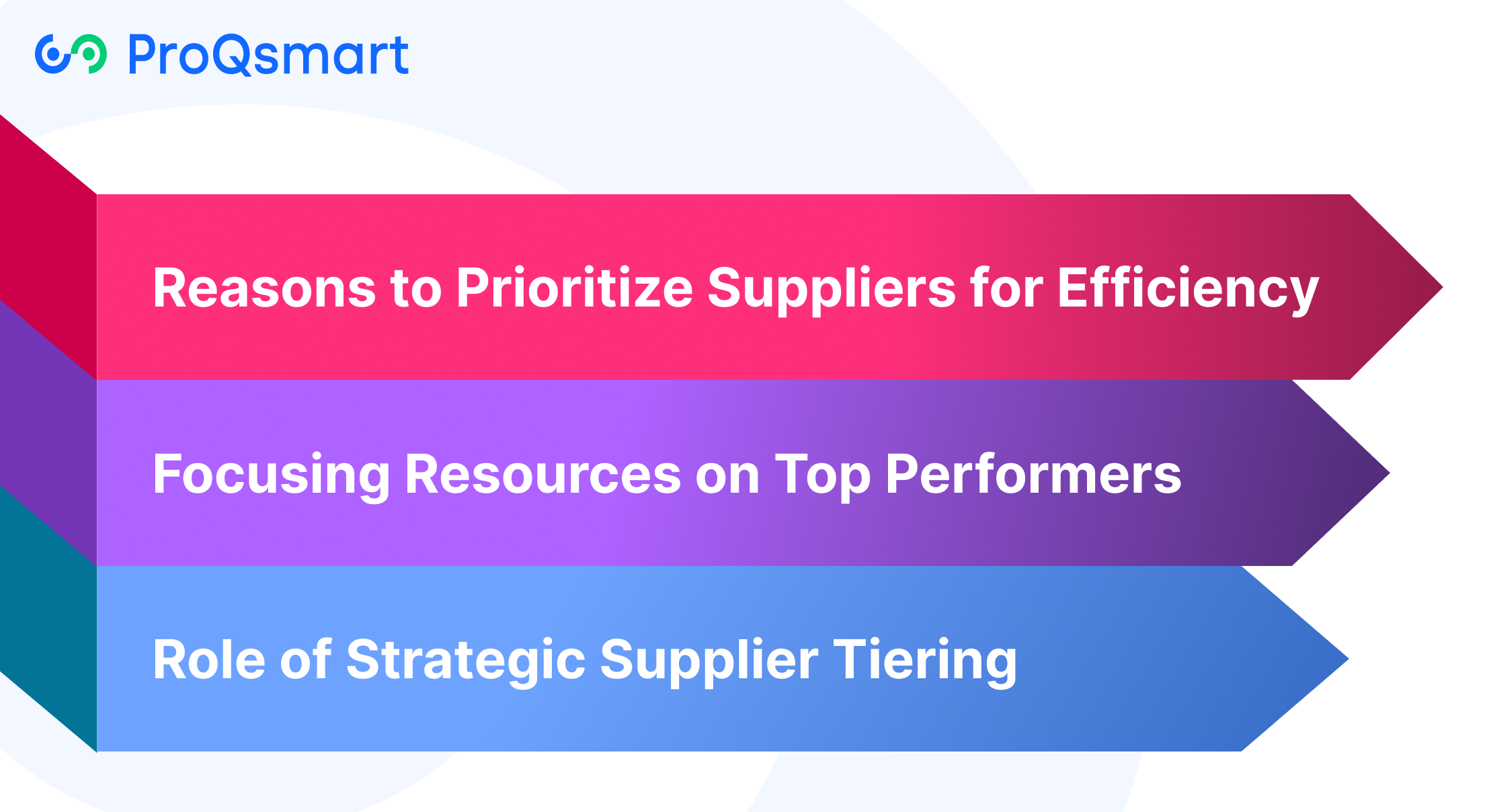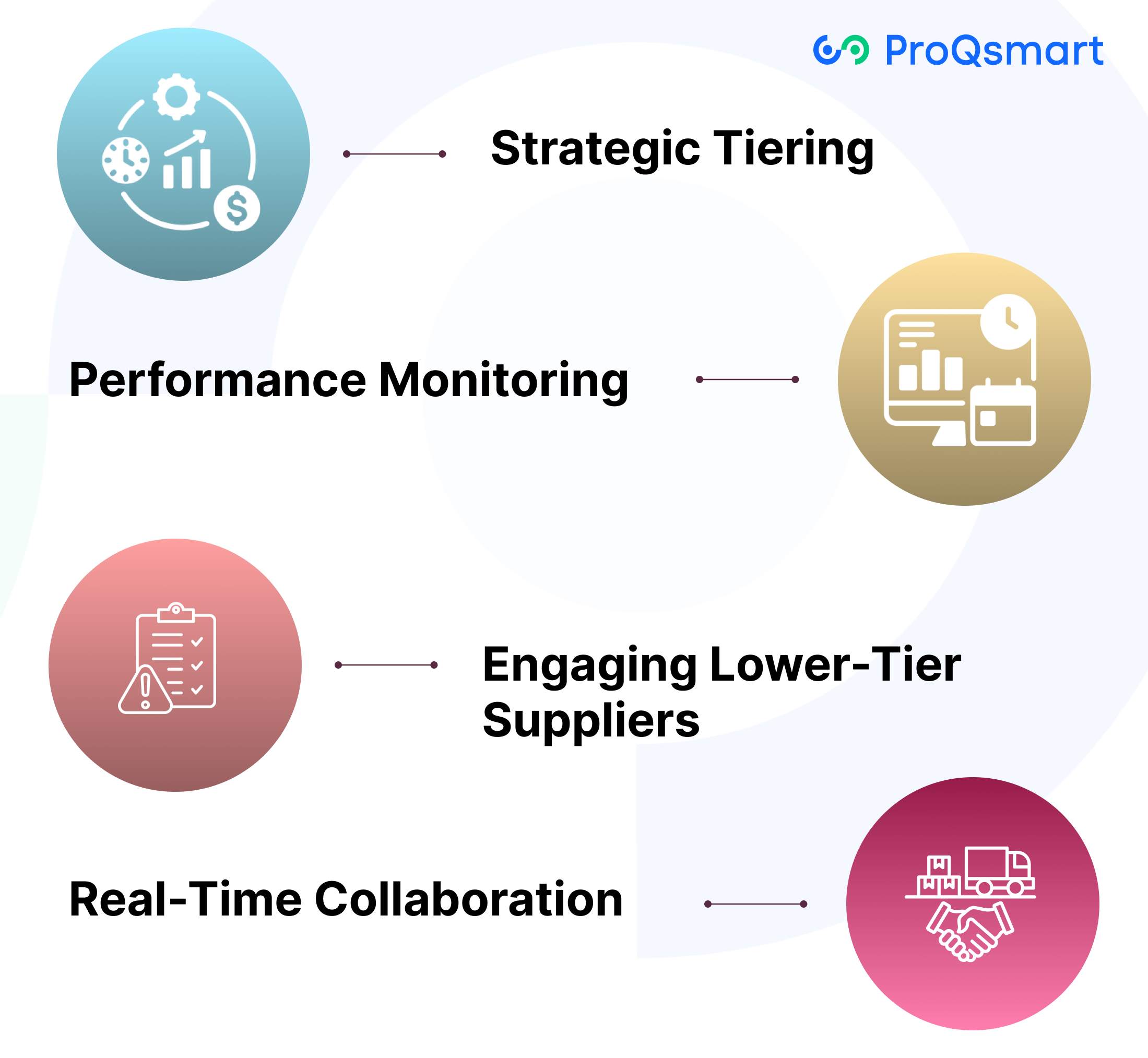Supplier management is the practice of managing and monitoring contractors and vendors to ensure the same quality, delivery and price over time. When companies focus on communicating clearly, they set themselves up for stronger tracking of their performance. This cooperative exchange helps them develop consistent supply chains that meet their sustainability-focused objectives.
Strategic supplier management transforms public procurement into a more efficient, risk-aware process that builds long-term partnerships with diverse suppliers—creating more value for the public. That’s why leveraging technology such as supplier management software and keeping up with government regulations are key to keeping you competitive in today’s market.
From contract negotiation through ongoing supplier performance management, each step aids in a more efficient system. As professionals in procurement, adopting best practices in supplier management helps meet organizational objectives while promoting sustainable and transparent operations.
Here’s a guide on ten actionable strategies to improve your supplier relationships for the better.
Why Supplier Priority Matters

Positive, effective supplier management processes are not merely a box to check; they are a vital driver of procurement efficiency. By prioritizing supplier relationships, procurement teams can establish efficient processes, avoid backlogs, and maintain quality standards.
Reasons to Prioritize Suppliers for Efficiency
Concentrating on your most important suppliers helps streamline the procurement process. By focusing time and energy on their most promising suppliers, companies can lower administrative burden, shorten cycle times, and ensure they can rely on supply.
According to a study from the Harvard Business Review, businesses with higher supplier priority see an 80% reduction in risks such as stockouts or stops in production. Prioritization helps procurement teams remain nimble, able to swiftly pivot to alternative suppliers in an increasingly dynamic marketplace in today’s multifaceted supply chains.
Focusing Resources on Top Performers
By directing resources to those trustworthy suppliers, you will encourage collaboration and create a track record of trust. High-performing suppliers set the pace in all measures, providing a steady flow of deliveries and meeting quality requirements on time.
Take for instance supplier priority agreements, which can address terms such as intellectual property, indemnification and more to form the groundwork for fruitful, lasting relationships. Tools like ProQsmart can enhance your efforts by automating workflows and proactively monitoring supplier performance.
Beyond keeping you compliant, they save your organization time and prevent costly errors.
Role of Strategic Supplier Tiering
Strategic supplier tiering helps you prevent over-dependency risk. It helps respond to shocks such as natural disasters or global disruptions by providing companies with a more diverse supplier portfolio.
Regular engagement and keeping everything in one place—including with all-in-one platforms like ProQsmart’s AI tools—helps build rapport and prevent surprises. This mindset helps to make sure that procurement delivers on strategic business objectives, while enabling economic, social, and environmental sustainability.
Tier Setup: Structuring Supplier Ranks
Creating tiers for your suppliers is an essential starting point for realizing and nurturing strong supplier relationships. This tiered structure not only allows companies to prioritize their attention and resources according to the most critical and risky suppliers but also enhances supplier management processes, providing transparency in procurement strategy.
Ranking Criteria for Suppliers
Instead, when tiering suppliers, focus on measuring them against key suppliers in the supplier management process.
-
Volume: The quantity of goods or services provided.
-
Criticality: Their role in maintaining uninterrupted operations.
-
Reliability: Consistency in meeting deadlines and quality standards.
-
Innovation: Contributions to product development or unique solutions.
Understanding Supplier Tiers
These are strategic collaborators essential to your supply chain success. Having healthy supplier relationships at this level can help secure competitive pricing, quality service, and on-time delivery.
They help Tier 1 succeed by feeding them critical sub-assemblies or raw materials.
Transactional Suppliers (Tier 3): They take care of small, one-off, easily purchasable maneuvers, usually to the detriment of price. Some industries might require additional tiers, depending on complexity.
Clear Rank Rules and Benefits
Setting defined criteria for ranks up front creates more transparent vendor selection. Additionally, this strategy goes a long way toward risk mitigation, including third-party breaches, which account for 60% of data breaches.
Tools such as ProQsmart make this process easier by automating compliance workflows, tracking performance, and facilitating compliance assurance.
Tiered management helps to limit the municipality’s liabilities while doing a better job of maximizing costs and supplier distribution compared to managing all vendors equally.
Tier Triumphs: Benefits of Prioritization
-
Key Partnerships: Prioritizing collaboration with Tier 1 suppliers is crucial for operational success. These partnerships yield tangible benefits, including better pricing, quality, and delivery schedules. Cultivating strong relationships with Tier 1 suppliers can secure favorable terms and drive improved supplier performance.
-
Building Trust and Efficiency: Ongoing collaboration with Tier 1 suppliers fosters trust and mutual investment in collaborative outcomes. This can lead to shorter manufacturing cycles and enhanced quality, as companies become more confident in their supply chains.
-
Risk Mitigation and Compliance: Working with trusted vendors like Tier 1 suppliers helps mitigate supply chain risks. Technologies such as blockchain and Web3 frameworks provide visibility and regulatory compliance, preventing disruptions and inefficiencies in multi-tier supply chains.
-
Innovation and Sustainability: Strategic partnerships with Tier 1 suppliers create opportunities for long-term collaboration and innovation. This forward-thinking approach fosters flexibility, sustainability, and joint success, which are critical in today’s dynamic markets.
-
Cost Savings and Efficiency: Focusing on high-value supplier relationships results in real cost savings. Precision tracking of multi-tier activity can lead to significant reductions, such as up to 15% savings on sub-tiered manufacturing efforts.
Tier Tangles: Challenges to Untie

Supplier management can quickly become complex if organizations lack a plan to address the challenges created by tiered structures. One significant challenge is managing strategic supplier relationships across different tiers, which can lead to disputes over tier assignments. These disputes often arise from unclear criteria or subjective scoring methods in the supplier management process.
Challenges in Tier Assignments
Misalignment in tier assignments frequently stems from a lack of clear, measurable criteria. For instance, a supplier with substantial market power but erratic performance might challenge their inclusion in a lower tier. Such disputes can erode trust and cooperation, emphasizing the need for a strong supplier relationship and consistent supplier management processes.
Disruptions from Tier Reassignments
Shifting suppliers between tiers mid-cycle can introduce significant disruptions. Reassignments can disrupt workflows, delay deliveries, and strain supplier relationships, particularly if the supplier onboarding process is not managed effectively. For example, moving a secondary supplier to a primary position without adequate preparation can lead to unmet expectations or capacity issues, highlighting the importance of systematic supplier management to minimize operational fallout during tier adjustments.
Importance of Quality Data
Using poor-quality or stale data in the supplier management process can lead to misguided decisions. Measurable metrics like fulfillment lead times, service level quality, and operational spend should be current and comprehensive. ProQsmart’s AI-powered procurement platform simplifies supplier information management by offering real-time data and supplier performance monitoring, ensuring decisions are reliable and actionable.
Engagement with Lower-Tier Suppliers
Lower-tier suppliers often feel overlooked, which can lead to a lack of engagement or performance. Engaging with these suppliers early, through periodic business reviews or joint planning software like ProQsmart, strengthens their bond with the organization and enhances supplier relationship management. Creating opportunities for real-time collaboration and transparent supplier management processes helps make every tier feel valued and motivated to perform optimally.
ProQsmart’s Tier: Elevating Supplier Strategy
ProQsmart is an enterprise procurement platform, designed from the ground up to revolutionize supplier management by leveraging technology and establishing automated, integrated workflows. ProQsmart transforms organizations into smart decision-making machines by equipping them with cloud-based AI-driven tools.
These tools help automate workflows and better align procurement activities to strategic objectives. Its unified platform combines performance analytics, real-time collaboration, and predictive models to simplify complex supplier networks while driving cost efficiency.
Leveraging Performance Analytics for Accurate Vendor Ranking
ProQsmart employs comprehensive performance analytics to evaluate suppliers. It ranks them based on measurable metrics like delivery timelines, quality benchmarks, and contract adherence.
Take the Supplier Performance Monitoring feature, for instance, which gives you real-time evaluations, providing actionable insights that help you keep your suppliers on track without fail. These revelations enable procurement teams to more effectively tier vendors by priority.
Consequently, they can anticipate and better align the right suppliers with the right projects—resulting in a more streamlined process.
Aligning Supplier Tiers with Procurement Goals
Better yet, the platform’s budget-driven procurement toolmakes it easy to keep all supplier activities directly tied to financial objectives. When tiering suppliers are aligned to an organization’s objectives, ProQsmart helps organizations allocate resources more effectively.
This alignment results in better strategy execution. For example, manufacturers powered by ProQsmart can track where capital expenditure is sourced from, enabling them to make quick, responsive decisions that have benefits for long-term resilience.
Dynamic Adjustments Through Real-Time Tracking
With ProQsmart’s suite for monitoring supplier performance in real time, tier changes can be proactive instead of reactive. With predictive models now able to help detect potential disruptions, businesses can take steps to mitigate risks before they come to fruition.
Tools such as transparent reporting and automated e-tendering make disseminating changes quick and easy. This increases responsiveness and builds positive supplier rapport on all projects.
Tier Tactics: Making Prioritization Work

-
Strategic Tiering: Aligning supplier rankings with business priorities ensures resources are focused where they yield the greatest return on investment. Tier 1 suppliers, who provide critical goods or services, require closer monitoring and collaboration due to their impact on operations and product quality.
-
Performance Monitoring: Regular reviews of supplier tiers and performance are crucial. Metrics like on-time delivery rates and adherence to SLAs provide actionable insights. Tools like ProQsmart simplify this process by automating assessments and ensuring alignment with operational and regulatory standards.
-
Engaging Lower-Tier Suppliers: Engaging Tier 2 suppliers is essential as they produce raw materials or intermediate goods. Performance incentive programs can strengthen their dedication and increase output, creating a more agile and robust supply chain.
-
Real-Time Collaboration: Real-time collaboration tools, such as those provided by ProQsmart, solidify partnerships across all tiers. Data-driven oversight and incentivization ensure high-quality output, maintain compliance, and enable swift adaptation to market changes.
Conclusion
Prioritizing supplier management is crucial for fostering collaborative relationships, improving operational efficiency, and minimizing compliance risks. By establishing a tiered system of prioritization, organizations can create a clear decision-making pipeline that drives impactful outcomes. This systematic approach prevents misunderstandings, builds collaboration, and ensures smooth project delivery.
A well-planned supplier strategy not only saves time and money but also keeps businesses adaptive and prepared for future challenges. Supplier management is more than just a transaction; it drives tangible growth and success.
To elevate your supplier management and build a smarter, more innovative, and sustainable supplier network, evaluate your existing process and consider solutions like ProQsmart. By doing so, you can enhance your approach and unlock the full potential of strategic supplier partnerships. Explore ProQsmart and book a demo today to discover how their innovative solutions can transform your procurement processes and drive business success.




